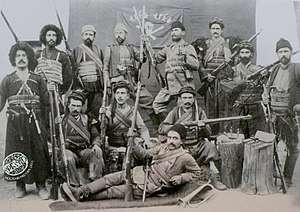Khanasor Expedition
The Khanasor Expedition (Armenian: Խանասորի արշավանքը, Khanasori arshavankë) was a punitive raid launched by Armenian fedayees against the Kurdish Mazrik tribe on July 25, 1897. In 1896, in the aftermath of the Defense of Van, the Mazrik tribe had ambushed and slaughtered many of the Armenian defenders of Van as they were retreating into Persia. The Armenian Revolutionary Federation decided to retaliate for that atrocity, resulting in the Khanasor Expedition.
| Khanasor Expedition | |||||||
|---|---|---|---|---|---|---|---|
 | |||||||
| |||||||
| Belligerents | |||||||
|
Armenian Revolutionary Federation assisted by Hunchaks and Armenakans | Mazrik tribe of Khanasor | ||||||
| Commanders and leaders | |||||||
|
Sargis Mehrabyan Nikol Duman Nikoghayos Mikaelian | Sharaf Beg | ||||||
| Strength | |||||||
| 250 fedayees | The entire tribe | ||||||
| Casualties and losses | |||||||
| 26, incl. Garo (Stepan Zorian's brother), Khan and Arisdages Zorian | Unknown; about 200 persons according to contemporary Ottoman claims,[1] almost all of the tribe's fighting-age males according to Armenian sources[2] | ||||||
Event
About a year after the events in Van, the Armenian Revolutionary Federation decided to retaliate and "punish" the Kurdish Mazrik tribe for its role in the Hamidian massacres and its ambush of the defenders of Van. The Mazrik tribe were camped in the fields of Khanasor, near Avarayr. The ARF, with the support of the Hunchakians and the Armenakans, organized an attack on the tribe. The operation was planned by Nikol Duman alongside "Khanasora" Vartan Mehrpanian and Ishkhan Arghoutian, all of whom participated as commanders of the operation. Among the Armenian soldiers also there were disagreements. For their settlement the party sent in Tavriz Harutiun Shahrigian and as a result they come to conclusion of holding an action. On 25 July 1897, at dawn, the 250 Armenian fedayees attacked and killed the fighting men of Mazrik tribe, sparing the women and the children, among whom the Mazrik chief, Sharaf Bey, learned Armenians were coming earlier and managed to escape by wearing women's clothing, leaving the women and children behind. The attack ended on 27 July 1897.[3]
Results
Although ARF founder Rosdom's brother Garo and 25 other fedayees were among the casualties, the Khanasor expedition was a small triumph for the Armenians, both militarily and morally. As a result, Armenians built up their self-confidence; their belief in their ability to defend themselves was now reinforced. To this day, the ARF remembers the event in commemorative ceremonies honouring the expedition as an important event in the history of the Armenian struggle for freedom.
Gurgen Mahari, as part of a critique of the effectiveness of the Armenian Revolutionary Federation, had a character in his novel The Burning Orchards question whether the high moral and strategic significance the Dashnaktsutyun gave to the Khanasor Expedition's results was justified, or whether the expedition, and other acts like the Ottoman Bank siege, were just isolated incidents whose sum total did not relieve the oppression of Armenians in the Ottoman Empire.[4]
References
- Claim made by the Vali of Van, as reported in the London Evening News, August 10, 1879, p3.
- Suny, Ronald Grigor, "They Can Live in the Desert but Nowhere Else": A History of the Armenian Genocide. Oxford: Oxford University Press, 2015, p. 143.
- Tasnapetean, Hrach (1990). History of the Armenian Revolutionary Federation, Dashnaktsutiun, 1890–1924. Oemme Edizioni. p. 50.
On July 25, the Mazrik fighters - nearly all the adult males in the tribe - were annihilated. A Turkish lieutenant visiting Sharaf was also killed; but Sharaf, disguised as a woman, managed to flee. By the strict order of the ARF commanders, all women and children were spared.
- Marc Nushanian, The Flames of Van, in Armenian Van / Vaspurakan, p280.
See also
- Armenian resistance